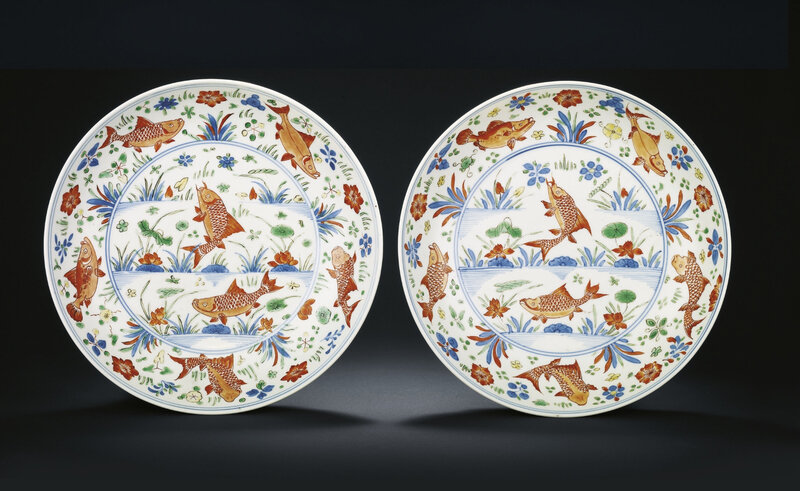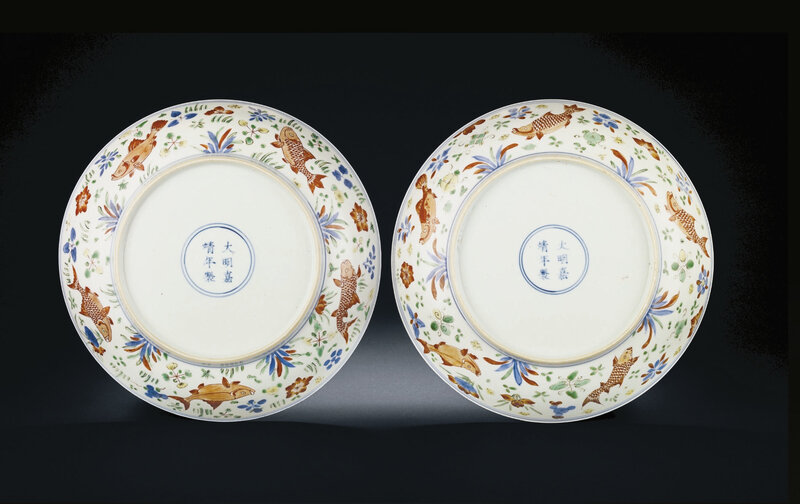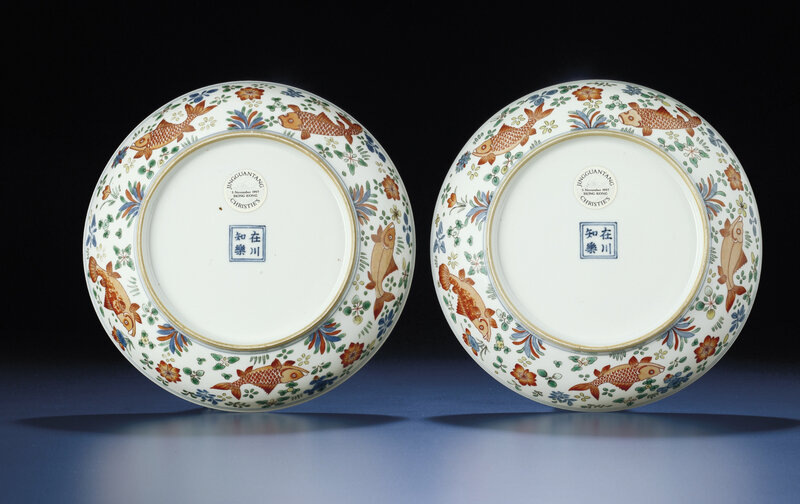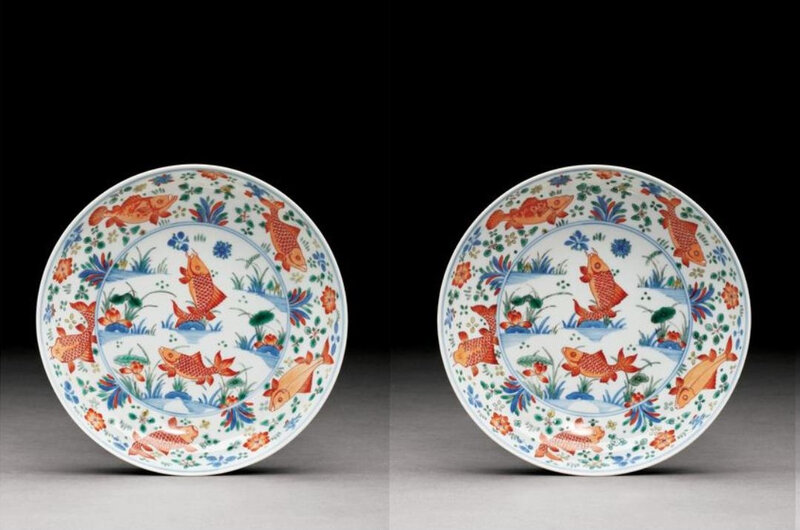Christie's. Hong Kong. Important Chinese Ceramics and Works of Art. 27 May 2008
A pair of wucai 'fish' dishes, Kangxi period (1662-1722)


Lot 1758. A pair of wucai 'fish' dishes, Kangxi period (1662-1722); 58 1/8 in. (20.6 cm.) diam. Estimate HKD 200,000 - HKD 300,000. Price Realized: HKD 295,500 © Christie's Image Ltd 2008.
Each painted in the centre with two iron-red fish, one leaping from the water, in a river pool with lotus and arrow-weed, in green, yellow and iron-red enamels with light underglaze-blue, the well similarly decorated with different sylised fish, all in iron-red, swimming amid pond weed and floating blossoms, repeated around the exterior, all between underglaze-blue double-line borders, the base with underglaze-blue daming Jiajing nianzhi mark within double-circles, stand and box.
Provenance: Kwong Fat Hong Antique, Hong Kong, acquired in 1984
Wah Kwong collection.
Exhibited: Hong Kong, Ching Porcelain From the Wah Kwong Collection, November 1973-February 1974, The Art Gallery, Institute of Chinese Studies, Chinese University of Hong Kong, no. 750
Note: Wucai decorated fish dishes first appeared during the Ming Dynasty, Jiajing period, a variation on the classic design found on large jars of this period.
The related, more simplified prototype for the design on the present Kangxi dishes, can be found on a Jiajing marked dish in the Percival David Foundation, London, illustrated by S. Pierson, Designs as Signs: Decoration and Chinese Ceramics, London, 2001, p. 17, no. 7 where the fish motif is discussed in detail.
A dish, very similar in design to the present pair and with the same apocryphal Jiajing reign mark, is in the National Palace Museum, Taipei , a illustrated in the Exhibition Catalogue, Good Fortune, Long Life, Health, and Peace: A Special Exhibition of Porcelains with Auspicious Designs, Taipei, 1995, p. 148, no. 71.
The design is more commonly found on dishes inscribed with the four character mark Zai chuan Zhi le, 'Rejoicing in the stream', examples of which can be found in several museum collections including one in the Palace Museum, Beijing, illustrated in The Complete Collection of Treasures of the Palace Museum - Porcelains in Polychrome and Contrasting Colours, Vol. 38, Hong Kong, 1999, p. 146, no. 134; another from the Shanghai Museum is illustrated in Zhongguo Taoci Quanji - Jingdezhen caihui ciqi, vol. 21, Japan, 1981, no. 70; compare also one in the Percival David Foundation, London, illustrated in Ming and Ming Style Polychrome Wares, Revised Edition, London, 2006, p. 61, no. A797.
.
A pair of dishes from the Jingguantang Collection with Zai chuan Zhi le marks were sold at Christie's Hong Kong, 5 November 1997, lot 875; and another pair were sold at Sotheby's Hong Kong, 11 April 2008, lot 2966.


From the Jingguantang Collection. A rare pair of finely painted wucai 'fish' dishes, Kangxi period (1662-1722); 8 1/8 in. (20.6 cm.) diam. Sold at Christie's Hong Kong, 5 November 1997, lot 875.

A fine and rare pair of wucai 'carp' dishes, Qing dynasty, early 18th century; 20.2 cm., 8 in. Sold for 2,527,500 HKD at Sotheby's Hong Kong, 11 April 2008, lot 2966. © Sotheby's
each well potted with rounded sides colourfully painted on the interior of the central well with a pair of iron-red enameled carp frolicking in a lotus pond, encircled on the cavetto with five other fish depicted in various poses swimming amidst water weeds and lotus, the exterior similarly painted with five further swimming carps, the base inscribed with the four-character mark zai chuan zhi le ('Discovering joy in the river (by fish)').
Note: Wucai dishes with this decoration are quite rare. Only a small group of these dishes are in noted collections including in the Shanghai Museum, illustrated in Kangxi Porcelain Wares, Shanghai Museum, 1998, cat.no. 179; two in the National Palace Museum, Taipei, with the same mark, illustrated in Qingdai Taoci Daquan, Taipei, 1986, pp. 116 and 117; and one in the Beijing Palace Museum, illustrated in The Complete Collection of Treasures in the Palace Museum, Hong Kong, 1999, cat.no. 134. An almost identical dish with an apocryphal Jiajing mark in the Shanghai Museum is illustrated in op.cit. 178.
The dish is based on the Jiajing prototype, which can be seen on a dish in the National Palace Museum, Taipei, illustrated in Good Fortune, Long Life, Health and Peace: A Special Exhibition of Porcelains with Auspicious Designs, Taipei, 1995, cat.no. 71 and a related one in the Percival David Foundation, illustrated in Stacey Pierson, Designs as Signs: Decoration and Chinese Ceramics, Percival David Foundation of Chinese Art, London, 2001, cat.no. 7.
The phrase on the base of the dishes, zai chuan zhi le, (Discovering joy in the river(by fish)), is a literary reference from the work of the 4th century BC philosopher, Zhuangzi. In his poem, "The Happiness of Fish," (Yuzhilei), Zhuangzi and his friend, Huizi, banter back and forth about this subject.
Zhuangzi and Huizi were strolling along the dam of the Hao Waterfall when Zhuangzi said, "See how the minnows come out and dart around where they please! That's what fish really enjoy!"
Huizi said, "You're not a fish — how do you know what fish enjoy?"
Zhuangzi said, "You're not I, so how do you know I don't know what fish enjoy?"
Huizi said, "I'm not you, so I certainly don't know what you know. On the other hand, you're certainly not a fish — so that still proves you don't know what fish enjoy!"
Zhuangzi said, "Let's go back to your original question, please. You asked me how I know what fish enjoy — so you already knew I knew it when you asked the question. I know it by standing here beside the Hao."
(Burton Watson, translation, The Complete Works of Chuang Tzu, New York, Press, 1968, pp.188-9.)

/https%3A%2F%2Fprofilepics.canalblog.com%2Fprofilepics%2F1%2F0%2F100183.jpg)
/https%3A%2F%2Fstorage.canalblog.com%2F03%2F02%2F119589%2F96711876_o.jpg)
/https%3A%2F%2Fstorage.canalblog.com%2F11%2F31%2F119589%2F94773502_o.jpg)
/https%3A%2F%2Fstorage.canalblog.com%2F20%2F83%2F119589%2F94772815_o.jpg)
/https%3A%2F%2Fstorage.canalblog.com%2F26%2F72%2F119589%2F75604929_o.jpg)
/https%3A%2F%2Fstorage.canalblog.com%2F59%2F60%2F119589%2F26458628_o.jpg)


/image%2F1371349%2F20240331%2Fob_0d7487_2024-nyr-22642-0859-000-an-unusual-sma.jpg)
/image%2F1371349%2F20240331%2Fob_a6f470_2024-nyr-22642-0857-000-a-large-black.jpg)
/image%2F1371349%2F20240329%2Fob_2f6b6c_854-1.jpg)
/image%2F1371349%2F20240329%2Fob_825c4d_2024-nyr-22642-0851-000-a-rare-black-g.jpg)